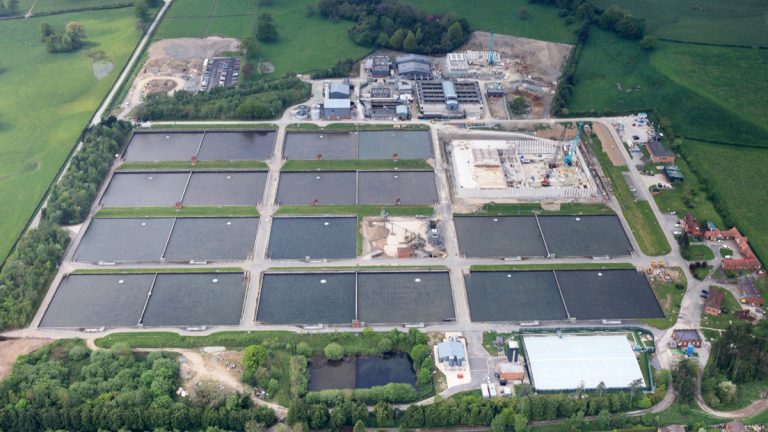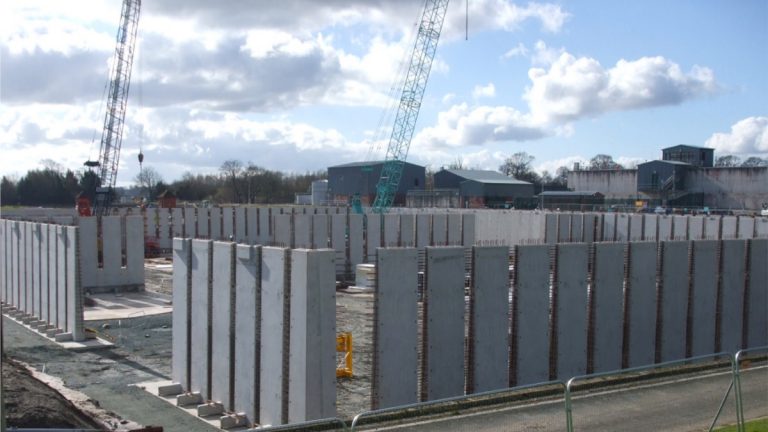Oswestry WTW (2016)

Oswestry WTW under construction - Photo by www.webbaviation.co.uk - Courtesy of United Utilities
United Utilities’ Oswestry WTW is located near to the market town of Oswestry, Shropshire on the England/Wales border. The original works became operational in 1892, near the end of the Victorian era, in response to the growing need for wholesome clean drinking water to Liverpool. It is a large works which treats raw water from Lake Vyrnwy Reservoir, providing drinking quality water to ~1 million domestic, commercial and industrial customers in Liverpool and parts of Cheshire. The raw water is fed 18 miles by gravity aqueducts from Lake Vyrnwy Reservoir to the nearby one day holding raw water Llanforda Reservoir. It is then gravity fed to the WTW from where treated water is gravity fed 50 miles by aqueduct pipelines to the supply service reservoirs in Merseyside and Cheshire. Once the upgrade project is completed the works will be able to provide up to 210Ml/d of wholesome drinking quality water to the latest standards well into the future.
Project drivers
The project is to upgrade the WTW to 21st century standards. The main project drivers at Oswestry WTW include:
- Improving manganese removal.
- Improving iron compliance.
- Reducing occurrences of discoloured water in the areas supplied by the works.
- Reducing the risk of bacteriological failures at the WTW.
- Restoring the WTW production output capacity to 210Ml/d.
- Improving overall control optimisation and efficiency.
The project is innovative in its approach both from the point of view of the process design and also the extensive modular off-site construction; about 60% of the plant is being manufactured off site.
It follows the tradition of innovation on the Vyrnwy/Oswestry supply to Liverpool as the Vyrnwy Dam design/construction of modular masonry blocks and over-the-crest spillway was the first of its kind in the UK. Over 40 lives were lost during the construction of the dam and it is useful to reflect on how far safety standards on site have improved, but also have a reminder of the constant need to be safety first vigilant in both design and construction.

Schematic of completed WTW – Courtesy of United Utilities
Process design
The process design of the new plant includes:
- Provision of a new clarification process stage (comprising coagulation, flocculation and settlement) to improve colour removal from the water with pre-oxidation using chlorine dioxide (ClO2) to help remove manganese.
- Modification and upgrade to the existing rapid gravity filters (RGFs) from direct filtration to conventional post-clarification filtration.
- Disinfection within a new contact tank and pH optimisation using lime water.
- A new clearwater tank provides on-site storage of treated water for security of supply.
Chlorine dioxide process
The process includes oxidation of manganese in the raw water using chlorine dioxide, a powerful oxidant which will facilitate manganese removal. Chlorine dioxide is generated on site using a reaction of PurateTM (a stabilised solution of sodium chlorate and hydrogen peroxide) and sulphuric acid, which are delivered in bulk to site. Chlorine dioxide generators mix the PurateTM and diluted sulphuric acid, producing an aqueous solution of chlorine dioxide which is piped to the point of application. Chlorine dioxide does not have the adverse side effect of forming trihalomethanes as would be the case using chlorine as an oxidant. No chlorine gas is used or produced in this process.
On-site hydro-generation
Both the new sophisticated control and green energy generation from the upgraded on-site hydro-generation will ensure a more efficient process. The turbine is designed, supplied and installed by subcontractor Your Hydro Ltd.
The Kaplan type turbine is mounted vertically within the powerhouse and has radial water entry through a profiled volute casing. By adjusting the runner blades and wicket gates (placed radially around the runner), Kaplan turbines can achieve very high efficiencies of up to 93%. This together with the ecological precautions being taken to minimise the effect on local flora/fauna reflects the intentions for an environmentally friendly project.
Safety & risk assessment
Safety and risk assessment has been paramount in the planning, design and construction, especially as the existing WTW remains operational. Regular risk assessment and review has been a constant theme on the project. One of the main challenges faced by main design and build contractor C2V+ (a joint venture of CH2M and VolkerStevin) has been in interfacing with the existing plant whilst still maintaining customer water supplies. Early input into the design for constructability and commissioning has been essential to mitigate risk of delays.

Oswestry WTW under construction – Photo by www.webbaviation.co.uk – Courtesy of United Utilities
Building information modelling (BIM) principles have been embedded in the design process. This has enabled virtual construction of the plant before its physical construction which has helped optimise routing of new services through the existing site and reducing risk of clashes. It has also helped in coordinating subcontractors, optimising available site storage space and minimising waste.
Modular approach
The design and construction is based on a modular approach which in this instance was deemed both quicker and safer than conventional methods of construction. It also provides better quality control through use of precast concrete panels. The two main new process structures (the clarification stage and the contact/clearwater tank) have been designed as predominantly precast reinforced concrete units (i.e. walls, columns and roof slabs Designed For Manufacture and Assembly (DfMA).
These are delivered to site ‘just in time’ and erected, with installation being completed by in situ cast reinforced concrete floors, stitches between wall panels, and in situ roof topping slab. Rigorous dimensional tolerance checks are carried out for the precast units during off-site manufacture and also when surveying the in situ installation once on site.

Clarification stage under construction – Photo by www.webbaviation.co.uk – Courtesy of United Utilities
Site preparations
The works are on an existing live operational plant and part of the site preparations have included extensive site investigations to prove the location of existing (sometimes Victorian) services, and foundation preparation work to ensure safe bearing capacity.
This has also included major on-site diversions of the main inlet pipework to enable the new works to be constructed. The site works for the preparation of the bearing foundations for the new works have included part demolition of the old Victorian slow sand filters. Materials from these sand filters is being recycled and reused where appropriate with no waste having to go off site to landfill.
The River Morda flows near the site and uncontrolled drainage from the site may end up in the river. The river is environmentally sensitive to any pollutant as well as being one of the first major tributaries joining the River Severn as it winds its way from mid-Wales, to the Bristol Channel. Dealing with surface water run-off and groundwater during excavations has therefore had to be carefully controlled. This presented a major challenge to the Contractor during the record high rainfall from November 2015 to February 2016. Excavations, especially where there is a risk to existing plant and water supply, are very carefully controlled.

Oswestry WTW under construction – Photo by www.webbaviation.co.uk – Courtesy of United Utilities
As each stage of the new plant is first constructed and then commissioned/brought onto line careful planning of the effect and risk to water supplies is revisited with the stakeholders. Rigorous formal controls are in place prior to any water going into supply.
Undertakings
A design and build contract was let in January 2015 by United Utilities under NEC3 to joint venture C2V+ (CH2M and VolkerStevin).
- Design and construct: C2V+ has undertaken the design and construction of the works supported by strategic partner Eric Wright Water, providing the main M&E work.
- Chlorine dioxide process: Scotmas Group is providing the expertise for the chlorine dioxide on-site generation and dosing equipment.
- Main structures: Carlow Precast Concrete Engineering (now FLI Precast Solutions) has undertaken the design, manufacture, delivery and installation for the main structures. Carlow’s design and manufacturing facility utilises carbon monitoring to minimise the mass for transport and craneage which reduces the total cement content.
- Rapid gravity filters: Western Carbons Ltd is undertaking the majority of the RGF modification/upgrade with new monolithic filter floors and media configuration.
- Lamellas: Hydro International Ltd is providing the design manufacture and installation of the new lamellas being installed within the new clarification stage (flocculation/ sedimentation basin).
Progress
At the time of writing (June 2016) the major new structures for the clarification and clearwater tank are well under construction and the new hydro-generation turbine house construction is being progressed.

Contact tank and clearwater tank under construction – Courtesy of United Utilities
The new lime plant construction in modular steel frame and cladding will commence mid-summer 2016. The plant includes lime powder bulk storage and batching to form lime water for dosing. The chlorine dioxide on-site generation and dosing plant is under construction.
The general electrical plant together with the instrumentation, control and automation is being enhanced or replaced. A new supervisory control and data acquisition (SCADA) system for remote monitoring and control is being provided.
Installation will follow once the main civil construction structures and mechanical/electrical installations are complete. The large pipework connections (new to existing) are being carefully planned and will be the final piece in the ‘jig-saw’ prior to full testing and commissioning.
The earlier reference to green energy hydro-generation contributes towards reducing the carbon footprint. The off-site manufacture of reinforced concrete items has also reduced the frequency of traffic to site. This has been welcomed by the local residents in view of the rural location and the narrow country lanes. Regular liaison with the public and other stakeholders has been very important.

Contact tank and clearwater tank under construction Photo by www.webbaviation.co.uk – Courtesy of United Utilities
Summary
The on-site construction works started early summer 2015 and, including commissioning and performance trials, the project will be completed in summer 2017.
Once the Oswestry WTW upgrade project is complete, the existing direct filtration will have been superseded and the old slow sand filters retired.













